Personalization is crucial in cold emails, but the manual process of researching prospects, gathering data, and crafting customized messages can be overwhelming, especially when managing a high volume of emails.
Sales reps often have to sift through articles, LinkedIn posts, and other sources to gather the necessary information. Due to time constraints, they might not be able to dedicate enough time to do thorough research, which can weaken the effectiveness of their outreach
But what if you could maintain the quality of personalization without the time-consuming manual work? This is where generative AI comes in.
Generative AI tools can accelerate your research and automate the creation of personalized emails, allowing you to focus more on strategy and less on repetitive tasks.
In this blog, we’ll explore 7 techniques for using AI to personalize your cold outbound emails. We’ll discuss the prompts that can fetch all the necessary information and the results you can achieve, helping you maximize your impact while minimizing effort.
7 Techniques Of Using AI for Personalizing Emails:
Here are 7 effective ways you can personalize your cold emails using generative AI tools:
- Highlight Company Milestones and Achievements
- Tailor Content Based on Business Model
- Address Industry-Specific Pain Points
- Personalize Based on Recent Product Updates
- Customize Based on Target Market and Geography
- Use Competitor Insights
- Utilize Targeted Job Titles and Personas.
1. Highlight Company Milestones and Achievements
Technique 1:
To personalize your outreach effectively using company milestones or achievements, you need up-to-date information such as the latest news, product launches, significant hires, quarterly results, and company events.
SDRs would spend hours manually gathering this data by sifting through LinkedIn, news sites like Reuters or Bloomberg, and participating in industry communities. This method can be time-consuming and may not always yield comprehensive insights.
With AI-driven tools, you can quickly uncover a company’s milestones and achievements. AI tools can scan the entire web, including news articles, press releases, social media, and other online sources, to provide you with relevant, real-time information.
So, what kind of prompt can you use to efficiently direct an AI tool to handle this research? Here is an example:
Prompt: "You are an SDR’s buddy. And you are responsible for the research and analysis of any given company or domain.
For the given company (DevRev), highlight the company’s recent milestones and achievements. Do not return information that is not uptodate.
(NOTE: For demonstrating these 7 techniques, we’ve used different company names as an example. You can replace it with the name of the company you want to gather information about.)
Use this prompt in Perplexity AI tool. It will research and give you a response as such:
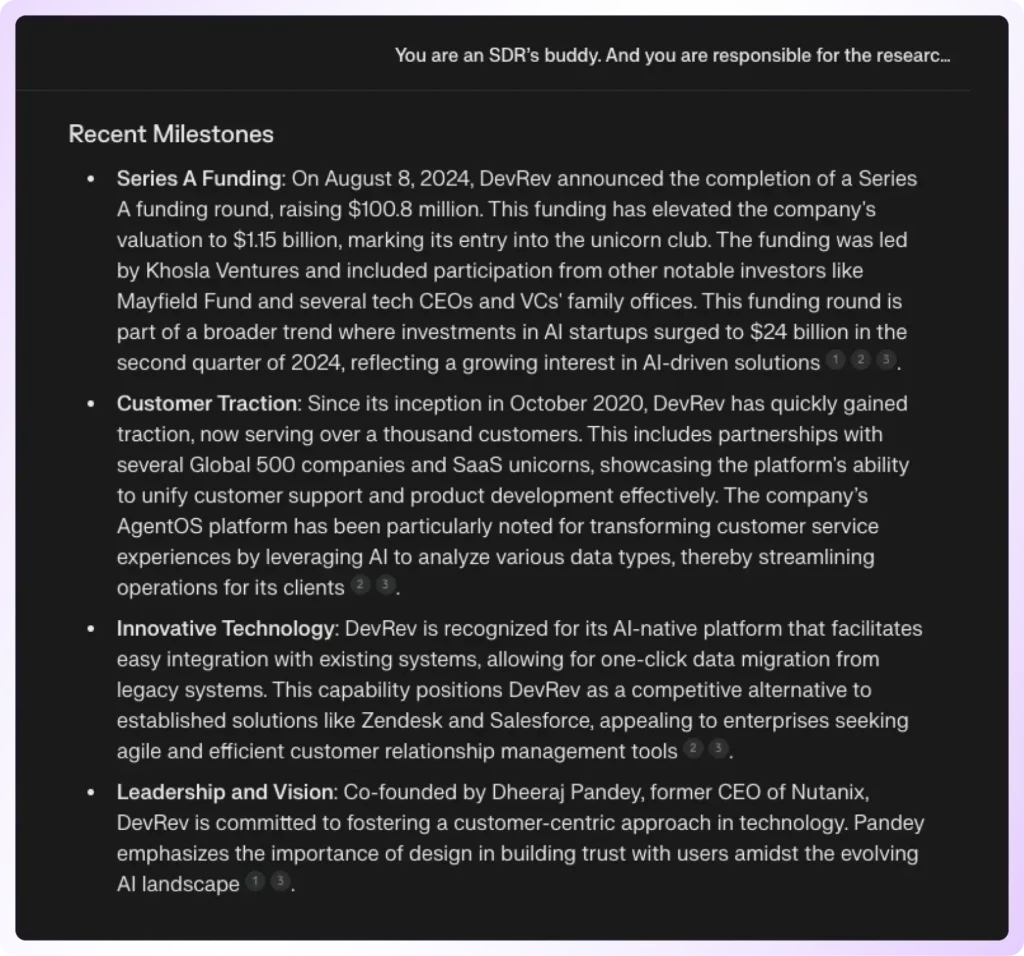
Now that you have solid information about your prospect’s company, you can use the same AI tool to personalize your email.
Simply provide the information to the AI and ask it to craft a personalized email for you in the style you prefer.
Here’s an example of how the personalized email may look:
Example Email: Hi [First Name],
Congratulations on [Company Name] reaching [specific milestone]! We admire your dedication to [specific goal or achievement]. Our [Product/Service] is designed to enhance your success by [benefit related to milestones].
Let’s explore how we can support your continued growth.
Best regards,
[Your Name]
2. Tailor Content Based on Business Model
Technique 2:
One way to do personalized outreach is by analyzing a company’s business model. You need to gather detailed information such as industry type, revenue streams, customer base, and sales processes.
SDRs start by analyzing the company’s website to understand its business model, identify key employee titles, and etc.
If the business model isn’t clear from the website, SDRs often turn to platforms like G2 to gain insights into what the company does and how it operates. This manual process can be tedious and prone to inaccuracies.
But with Gen AI tools like GPT4 & Perplexity, you can breeze through this process.
AI-driven prompts can quickly analyze vast amounts of data, including industry reports & company websites to give you a clear understanding of the prospect company’s business model.
Here’s a prompt which you can use in any advanced AI tool such as Perplexity,
Prompt 2: You are CEO’s Chief of Staff and you will have to do a business model study of given company domain to present to your CEO.
You will present your output in the following structure
- Business Model (b2b or b2c or both) - and a 1-liner of why you think it is b2b/b2c/both
- Revenue streams
- Industry type
- Customer tier they focus on (Mid-market /Enterprise /startups)
Given company domain - https://www.techmahindra.com/
The tool will do the research part and will provide you with the information like,
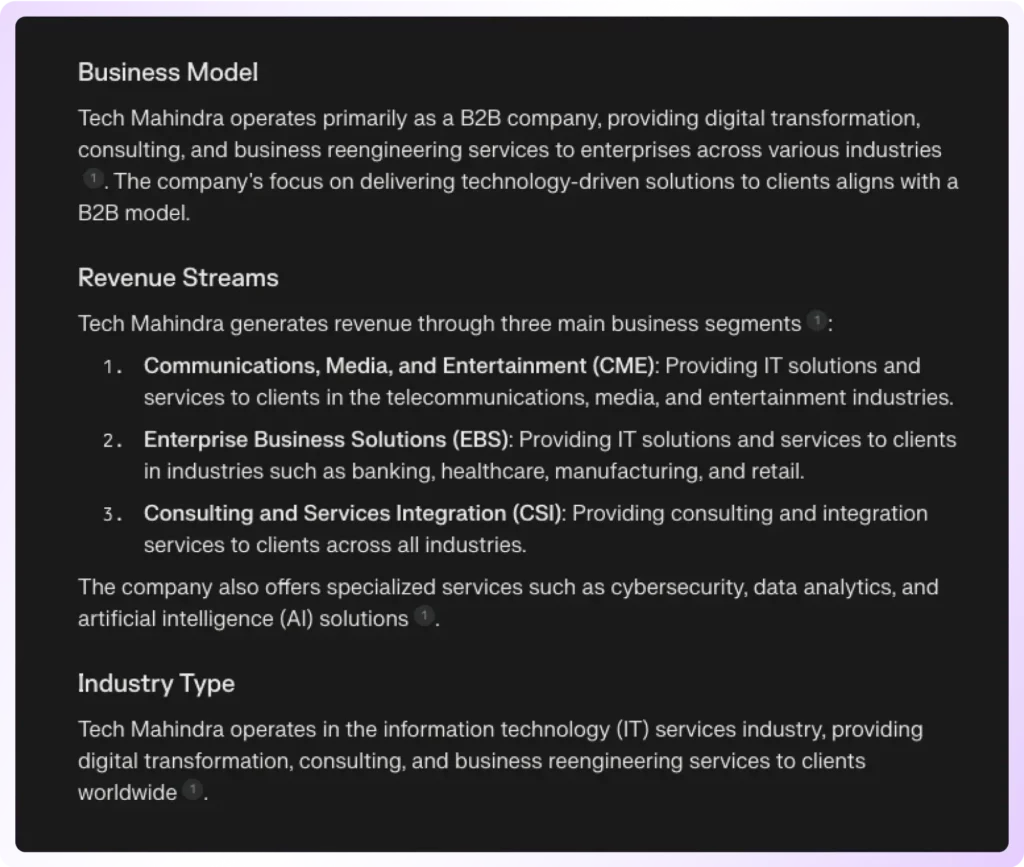
With this information in hand, you can then use a Gen AI writer to craft personalized email content that may look like this,
Example Email: "Hi [First Name],
Understanding that [Company Name] operates on a [business model] model, our [Product/Service] can seamlessly integrate to boost [specific aspects related to their model].
Would you be interested in a demo to see how it aligns with your revenue goals?
Best,
[Your Name]"
3. Address Industry-Specific Pain Points
Technique 3:
Personalizing outbound emails by addressing industry-specific pain points and buying triggers is one way to do effective outreach.
SDRs spend significant time identifying these pain points by analyzing the prospect’s customer base, reviewing industry reports & monitoring social media conversations.
They also browse LinkedIn posts, participate in relevant communities, and directly connect with employees from target companies. Instead of relying on this time-consuming manual approach, generative AI tools can rapidly analyze vast amounts of data and give you insights.
Here’s an example for a prompt which will give you the insights you need:
Prompt 3: You are an SDR’s buddy and you will have to analyze and understand the prospect industry’s pain points very well.
You will present your analysis of the given domain’s industry pain points and summarize it in the following way
- Needs and pain points they address
- Buying triggers
Given company domain - “https://rocketreach.co”
Get me the needs & pain points of Rocketreach so that I can position my product better.
The tool handles the research and delivers the specific information you need.
Here’s what you get as output:
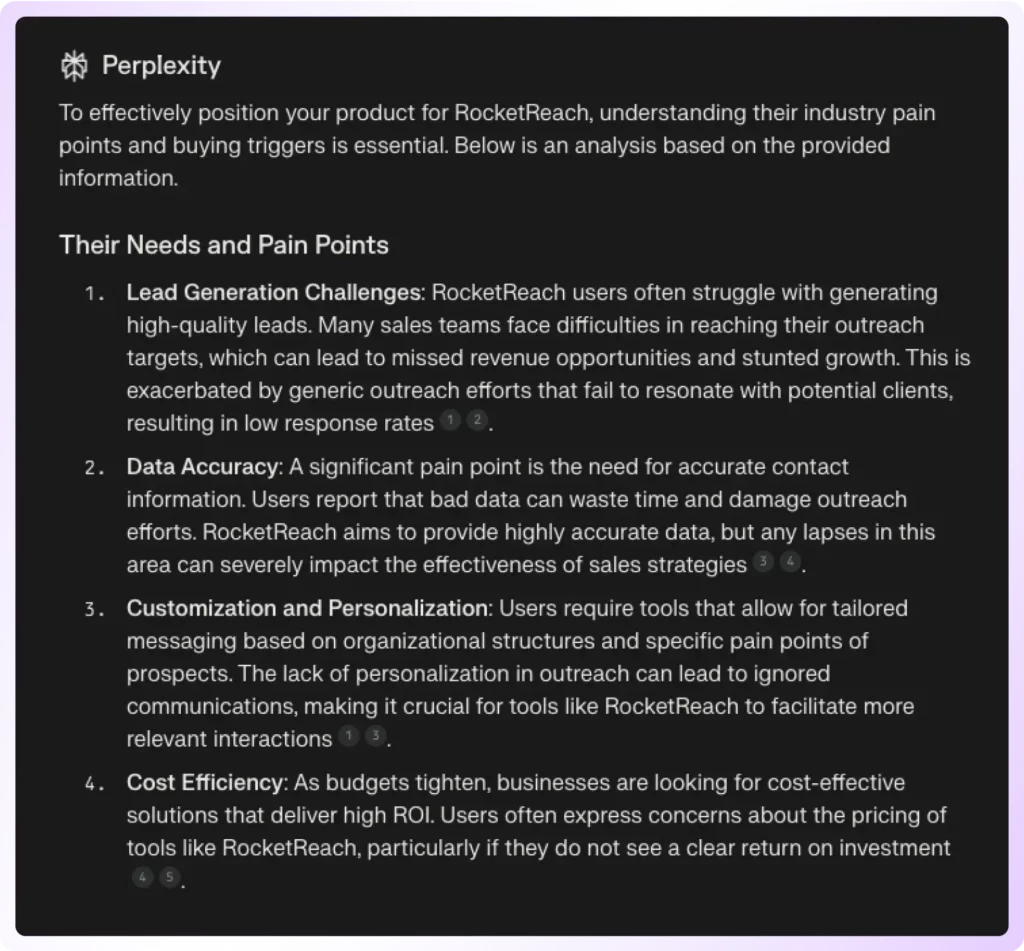
With this information at hand, you can then use a Gen AI writer to craft personalized email content that may look like this,
Example Email: "Hi [First Name],
We know that [Company Name] faces challenges with [specific pain point]. Our [Product/Service] is designed to tackle these issues by [solution offered].
Would you like to discuss how we can help?
Best,
[Your Name]"
4. Personalize Based on Recent Product Updates
Technique 4:
One good way of tailoring your cold emails is by being informed about a company’s recent product updates or feature launches by gathering the latest insights from public announcements, press releases, and social media.
SDRs manually gather this information by researching LinkedIn posts, company newsletters, and staying updated on various industry channels.
Whereas generative AI tools can do this process for you. You can use AI-driven prompts to quickly find out the latest product updates and feature launches.
For example, here is a prompt which you can use in an AI tool like Perplexity.
Prompt 4: "You are an SDR’s buddy. And you are responsible for researching the product updates of the given company domain - https://notion.com/
For the given company, highlight the recent product launches and updates found in public blogs or announcements or news releases. Ensure you backup your answer with relevant article reference or website references, do not do a derivative answer.
Structure your output in a chronological manner.
Time period - past
With this prompt, the tool can do a solid research and get back to you with a response as such,
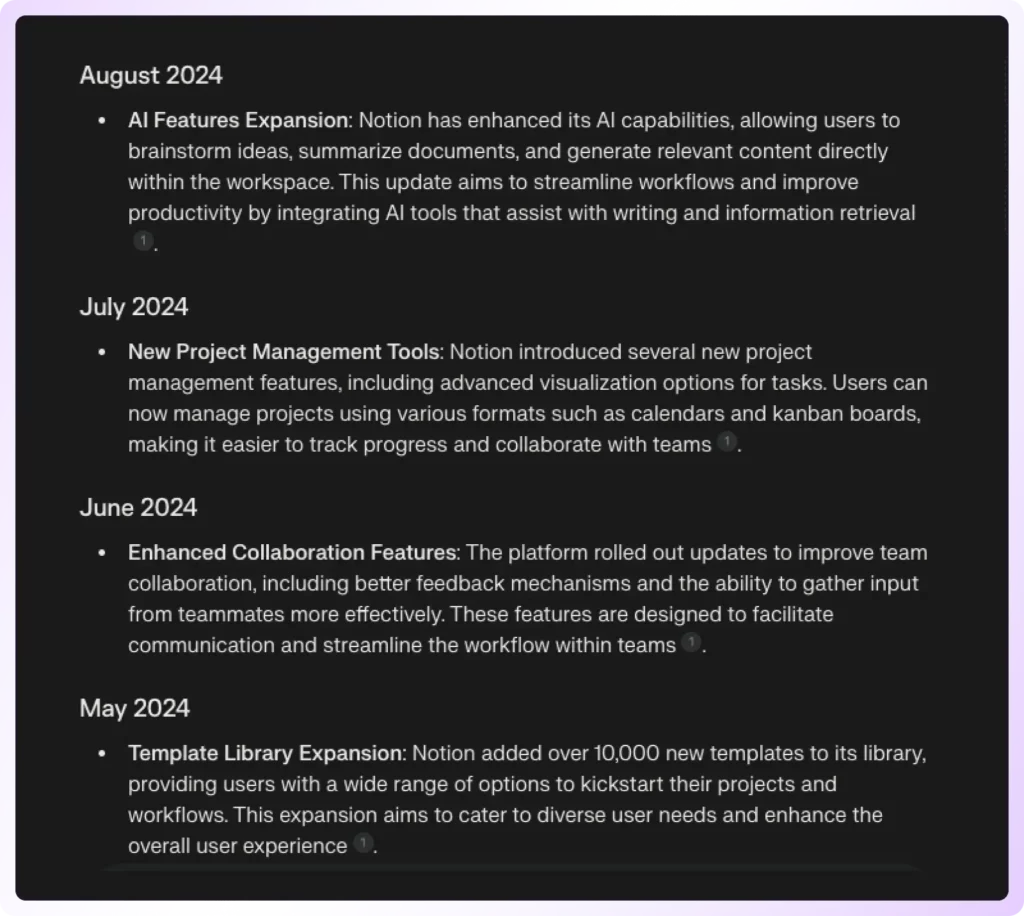
Use this information to structure your personalized email which can look like this,
Example Email: "Hi [First Name],
I noticed [Company Name] recently launched [new feature/product]. Our [Product/Service] can enhance this by [specific benefit related to new feature].
Let’s explore how we can add value to your new offering.
Best regards,
[Your Name]"
5. Customize Based on Target Market and Geography
Technique 5:
Personalizing outreach by understanding a company’s target market and geographical focus typically involves SDRs conducting manual research.
This research includes following other SDRs and AEs in the industry on LinkedIn, where they frequently discuss their company’s market strategies.
This is labor-intensive and might still leave gaps in the research process.
But Gen AI tools are here to save the day. These tools can provide a comprehensive overview of a company’s target market and regional focus, allowing you to craft emails that are relevant and resonate with the recipient.
So this is a prompt which you can use,
Prompt 5: "You are an SDR’s buddy. And you are responsible for the research and analysis of any given company or domain.
For the given company DevRev, highlight the company’s target market and geographical focus at the moment. If you do not find any insights related to this information, then do not make up the information. Ensure you backup your answer with relevant article reference or website references, do not do a derivative answer.
Fetch the result in the following format
Company name
Primary target market
Other possible target market(s)
Expansion possibilities (Geographically)"
This will give you a response as such,
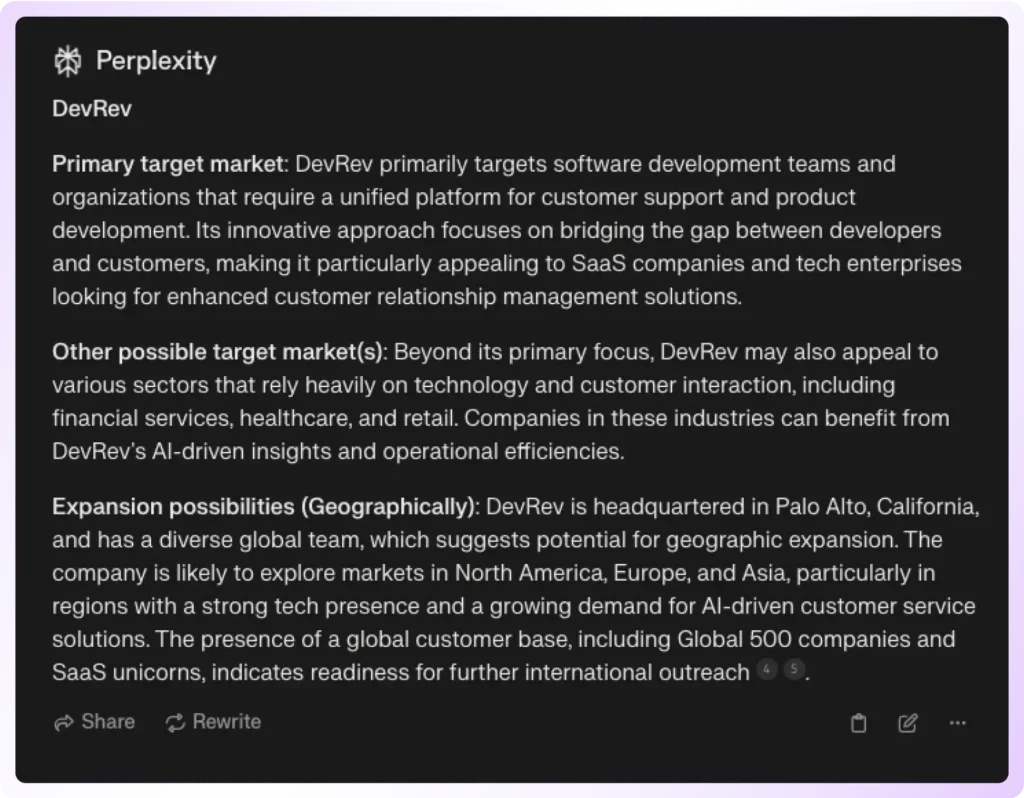
Use the response to structure your personalized email which can look like this,
Example Email: "Hi [First Name],
Considering [Company Name] is focusing on [specific region or market], our [Product/Service] is optimized to meet the needs of [specific audience in that region].
Interested in a demo tailored to this market?
Best,
[Your Name]"
6. Use Competitor Insights
Technique 6:
To personalize your cold emails by analyzing competitors, you need insights into the tools used by prospect companies and details about competitor products. SDRs traditionally gather this information by examining job postings on LinkedIn, especially the "Job Description" and "What You’ll Do" sections, to understand the technologies employed by the prospect company.
They also review G2, focusing on negative feedback to identify competitors' weaknesses.
This process can be tedious, but AI tools can simplify it. While AI tools can’t access information behind login walls, you can use tools like Builtwith, which rely on their own databases, to reveal the products a prospect company uses.
With this information, you can then ask AI tools to identify the strengths and weaknesses of those products
Here’s a prompt that you can use in Perplexity AI tool with the information you gathered,
Prompt 6: You are an SDR’s buddy and you will have to do a comparative study of competitor insights to convince your prospect well.
To do this, you will need to present me with information on
2 strengths and 2 weaknesses of the tool “Click Up”- project management tool.
The response would look like this,
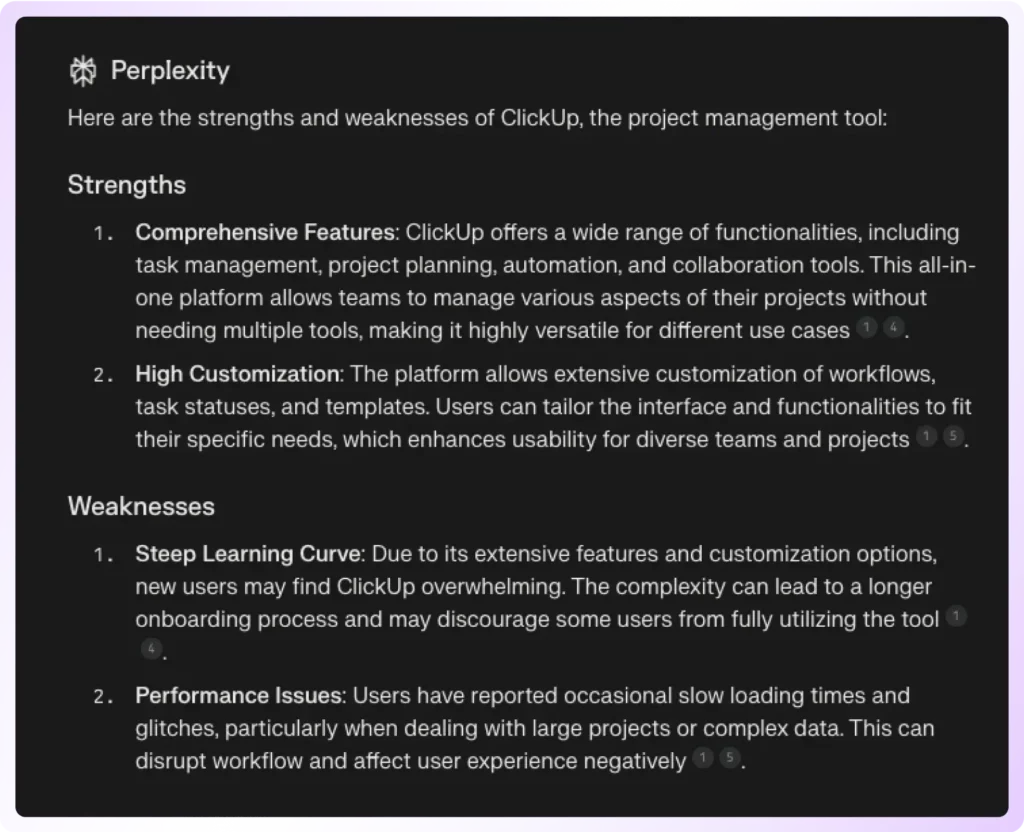
Use this information to structure your personalized email which can look like this,
Example Email: "Hi [First Name],
We’ve noticed [Company Name] is exploring solutions similar to [Competitor's Product]. Our [Product/Service] stands out by [unique feature or benefit].
Could we schedule a call to show you the difference?
Best regards,
[Your Name]"
7. Utilize Targeted Job Titles and Personas
Technique 7:
You can enhance your outreach by targeting specific decision-makers within a company. Traditionally, SDRs identify these key decision-makers by meticulously browsing LinkedIn profiles, analyzing job titles, and understanding the roles of individuals within the prospect company.
Since generative AI tools can’t access information behind LinkedIn’s login walls, you can turn to tools like Leadlabs and Klenty's disc agent (placeholder name) to analyze and segment your audience based on job titles and personas within the company. These tools leverage their own databases to provide relevant information on decision-makers.
With these insights, you can craft personalized emails that directly address their specific responsibilities and challenges.
Here is an sample prompt that you can feed to an gen AI tool to craft a cold email,
Prompt 7: “Craft an email that speaks directly to the responsibilities and challenges faced by [Job Title] at [Company Name], highlighting how our [solution] addresses their specific needs."
This will craft you a neat cold email as such,
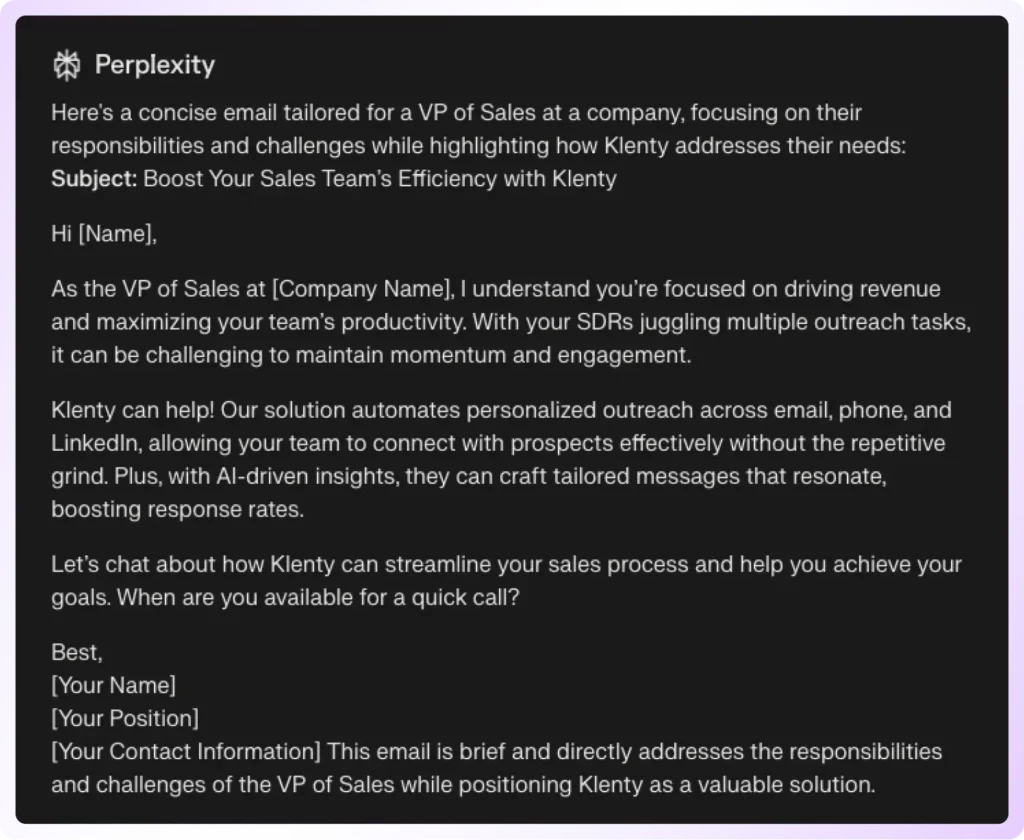
Example Email: Hi [Recipient’s Name],As the [Job Title] at [Company Name], I understand the challenges you face in [mention specific responsibilities, e.g., managing projects, overseeing team performance, increasing operational efficiency].At [Your Company], our [Your Solution] is designed to help professionals like you overcome these challenges. Here’s how:
[Feature 1]: Automate repetitive tasks, allowing your team to focus on high-priority projects.
[Feature 2]: Make data-driven decisions faster and improve overall productivity.
We’ve helped companies like [mention a relevant case study or client] achieve [specific results & I’d love to discuss how [Your Solution] can provide significant value to [Company Name]. Are you available for a brief call next week?
Best regards,
[Your Name]
[Your Job Title]
[Your Company Name]
[Your Phone Number]
These are the 7 different ways to use AI for personalizing your outbound emails.
Now, the best part is Klenty has built a smart tool named sdrX.ai and with it, you can implement each of these techniques with ease as it can take care of both the research part and the email crafting part. It will do the heavy lifting for you.
Want to see how it works? Book a demo with us today.

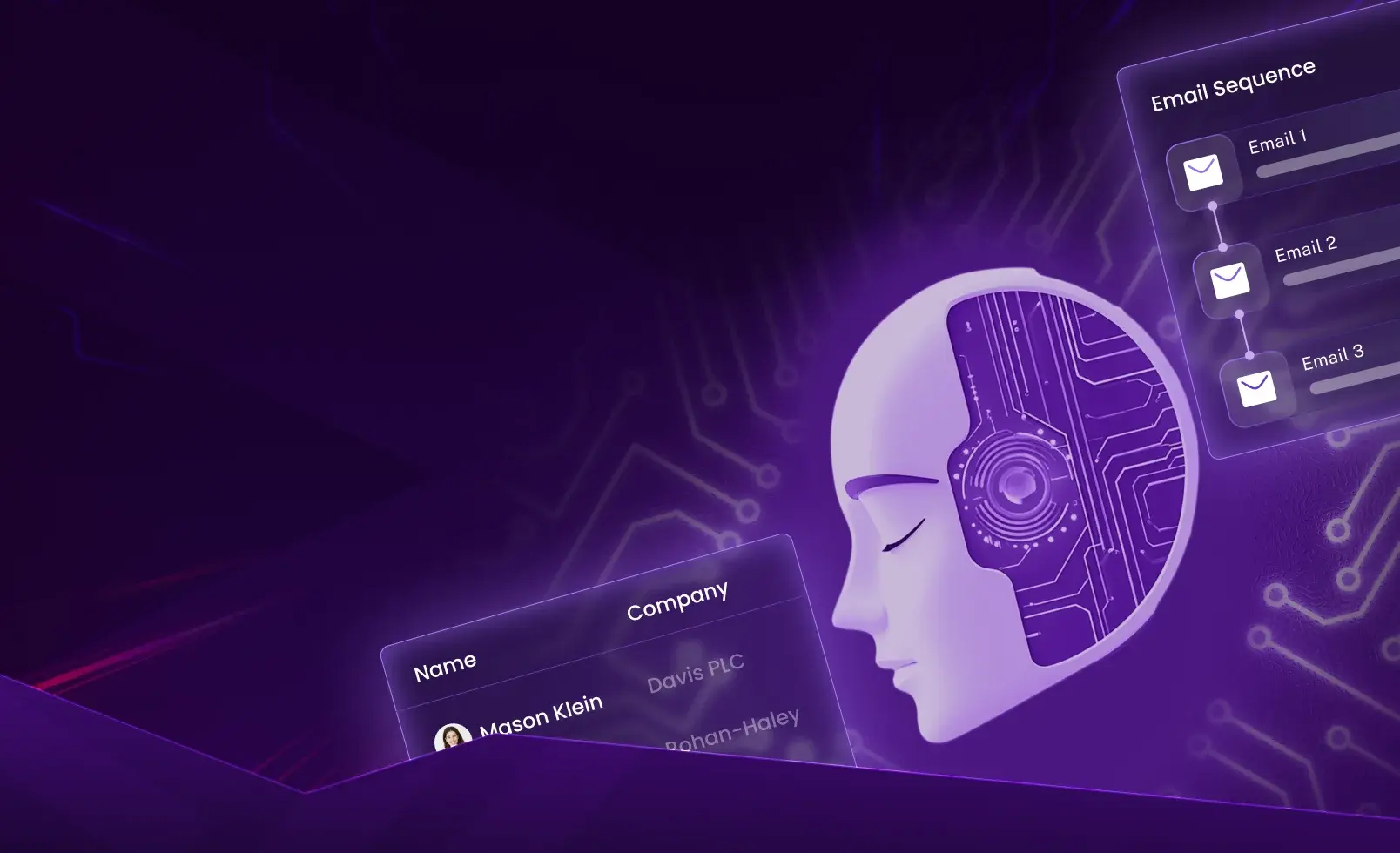
 Terms
Terms